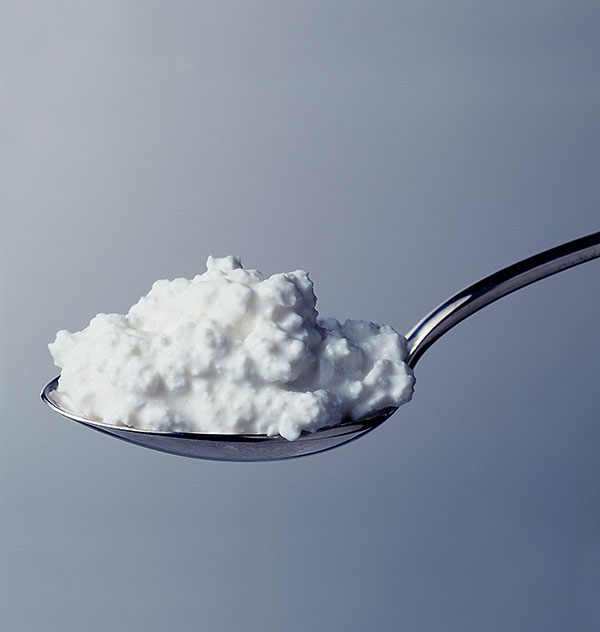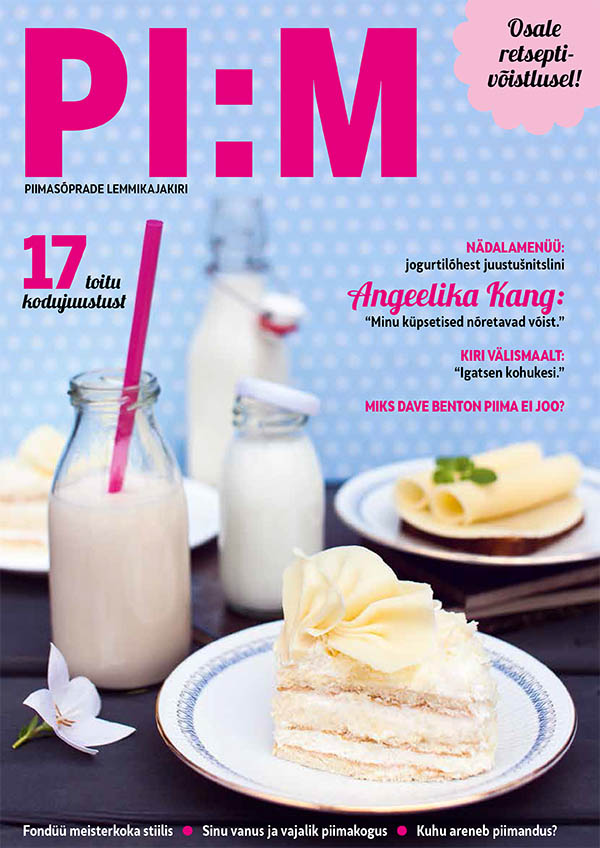milk | butter | kefir | cheese | yogurt | sour cream | buttermilk | sour milk | cottage cheese | curd | pudding
 Treasury of Nutrients in Curd
Treasury of Nutrients in Curd
Curd is more of a solid than a liquid product. An essential part of the dry matter of curd is comprised of proteins, but it also contains carbohydrates, fats and minerals. There is a significant amount of water (78-82%) in curd, bound with proteins.
Curd contains free water as well ‑ the liquid that has dripped between the twofold package of curd shows it. Technologically, it would be possible to produce curd with a low water content as well, however, it would taste dry and dull.
Many of us realise that curd is good for one’s health. What exactly makes classical curd a product that has a favourable effect on human health?
The main ingredient in curd is casein, the reserve protein of milk which gives the product its white main colour. The primary biological value of the curd is in its high protein content (usually 10-12%) which varies a little by curd variety.
All milk proteins contain amino acids essential for the correct functioning of the human body (including the irreplaceable ones), and what is especially important, in the appropriate proportions. We should particularly highlight the high methionine content of the curd proteins; it is an irreplaceable amino acid which, among other things, protects the liver against becoming fat.
When classical curd is modified, curd with its highly valued proteins still remains as the main ingredient, so it is reasonable to add healthy ingredients, and they create added value; however, curd remains as the source of proteins with high biological value for the human body.
Natural curd cannot boast of a high carbohydrate content. Carbohydrates, mostly milk sugar or lactose, make up 2-3% of natural curd. Compared with milk, the lactose content of curd is lower for two reasons. Firstly, some of the lactose remains in the whey, and secondly, if curd is produced from milk fermented with starter bacteria, a part of the milk sugar is used for producing organic acids as well as for the functioning of the lactic acid bacteria.
However, the picture changes entirely in the case of sweetened curd creams. Both sugar and other sugar-rich ingredients have been added to curd creams and their carbohydrate content is quite high. A separate group consists of so-called diet curd creams which are made from fat-free curd paste sweetened with jams flavoured with artificial sweeteners that give no energy to the human body. This alternative is not very reasonable since artificial sweeteners can cause problems for the human body if a lot is consumed continuously.
The fat content of curd can be significantly changed. Depending on the technology, it is possible to produce practically fat-free curd (less than 0.2% of fat), curd with a medium fat content (4-5%) and fatty curd (9% of fat). Curd fats provide fatty acids to the human body. The fats of the classical curd contain 20-25% of mono-unsaturated fatty acids which do not oxidise and are healthy.
People are often mislead by the idea that curd with a lower fat content doesn’t taste good. Contemporary production technology makes the curd particles so small that when you eat it, you feel their softness in your mouth, like the softness you feel when eating products with a higher fat content. However, you should bear in mind that the human body cannot fully assimilate all the nutrients such as certain fatty acids and fat-soluble vitamins from fat-free curd too quickly.
Curd contains very few water-soluble vitamins since some of them are destroyed during heating in the manufacturing process, and some remain in the content of the whey. Curd is quite rich in calcium and phosphorus, but it cannot compete with liquid milk products when it comes to supplying the human body with these essential mineral compounds.
Curd owes its sour taste to organic acids, particularly lactic acid. The organic acids in the product stimulate the functioning of the digestive glands as well as the absorption of nutrients (such as various microminerals). Consequently, curd is a valuable food product and nowadays it should definitely be included in everybody’s diet, especially that of children and the elderly.
Curd with Additional Ingredients
Additional ingredients serve two purposes. Firstly, to supplement the main food product with other nutrients, both in terms of quantity and product characteristics, and secondly, to diversify the product mix both in terms of flavour and appearance. Usually, various fruits and berries, such as raisins, apricots, bananas, strawberries, as well as cocoa are added to the product.
With additional ingredients, the proportions of the main nutrients that provide energy are changed in the product, and then they rank as follows: carbohydrates come first, proteins second, and fats occupy third place.
The use of vegetarian ingredients (fruits and berries) adds value to curd in several ways. For example, the product is enriched with fibres (prebiotics) which belong to the family of carbohydrates. The spectrum of fibres is also extended by the pectin that is added to some products in the technological process.
All vegetarian ingredients increase the content of useful potassium compounds in the final product. Berries and fruit enrich the product with vitamins and various anti-oxidant compounds. The appearance of the product is also changed, both thanks to the vegetarian components and the natural colorants (beta carotene, beetroot red).
ll the additives also contribute to the new flavours of the product, which, in turn, increase the number of the consumers of this protein-rich product. It is common that various additional ingredients account for 2-6% of the final product composition. However, there is the opposite possibility too – curd itself can be an additional ingredient in bread, pies, cheese cakes, pancakes, tarts, etc.
Curd Creams – Ready-Made Desserts
Dairy industries have expanded their product ranges, so there are various ready-made curd creams and desserts on the market. Desserts made from curd cream consist of various components and sometimes have two phases (curd cream and liquid).
In order to maintain their texture during the shelf-life, various additives, mostly stabilisers and thickening agents, are needed, such as starches, pectin and gelatine.
In general, preservatives are not added to curd. Potassium sorbate (E202) is the exception – it is added to a few products. Every consumer, however, can find a suitable preservative-free product from the wide range of products. You should take into account though, that a moderate quantity of preservatives can be found in any jams that have been used as flavouring.
Additives are also contained in diet curd mixes flavoured with artificial sweeteners. However, most of the curd desserts are sweetened with sugar. Citric acid (E330), citric acid salts, occasionally even lemon juice are added to these products in order to balance the sweet taste.
Despite the absence of preservatives in most of the products, curd desserts keep well. A long shelf-life is ensured by the use of high quality raw materials and the closed production cycle implemented in dairy industries where curd paste is not exposed to human contact until the product has already been packaged.
Since curd is a bit acidic, this specific feature also hinders its microbiological deterioration. Nevertheless, curd creams should always be stored at a cold temperature of 2–6 oC and consumed before the end of their shelf-life. If you remove the foil from the cream cup and you notice a layer of water on the curd paste, you needn’t be afraid that the product is spoilt. Curd cream settles when it’s allowed to stand, and a thin layer of water may form on it.
Curd creams are sold in packages of various sizes – so each consumer can choose the one that suits them best and if needed this also helps them to count their calories.
Share ►


